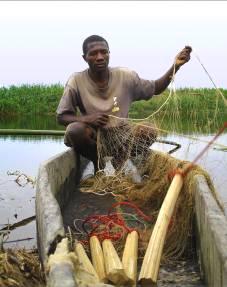The Buruli Ulcer is an extremely debilitating skin disease, in full emergence in West Africa. The first results of a case-control study of factors associates with the development underway in the endemic region by the Centre Pasteur du Cameroun, in collaboration with the researchers of many other teams, published in PLoS Neglected Tropical Diseases, confirm the presence of the already suspected risk factors and suggest the protective role of the use of mosquito screens.
Press release
Paris, december 19, 2007

In order to identify the risk factors associated with the development of this disease for which little is yet known and which is considered as “neglected”, a significant case-control study was conducted in Cameroon by Sara Eyangoh (Mycobacteria laboratory) and Régis Pouillot (Epidemiology and Public Health laboratory), of the Centre Pasteur du Cameroun in Yaoundé. This study benefited from the commitment/expertise of members of many other teams, one being the Emerging Diseases Epidemiology unit of the Institut Pasteur in Paris.
The results of this study provide important information for the prevention of Buruli Ulcer. They also open up research possibilities on its method of transmission, for which the current lack of awareness restricts the possibilities for controlling the disease and its treatment.
The characteristics and the lifestyle of patients suffering from Buruli Ulcer have been compared to the ones of individuals displaying any clinical signs of this skin disease (in total 168 “pairs” of individuals), in an endemic region in Cameroon within the districts of Akonolinga and Ayos, close to the marshes of Nyong.
The risk factors identified are the contact with stagnant water, wearing clothes that do not cover all the body parts during farming activities and the lack of recourse to antiseptic solutions when any care is given to skin wounds. The protective factors described are the use of mosquito screens, regular washing clothes, fishing in the Nyong waters* and the correct care of skin wounds with antiseptic solutions.
The authors conclude that the “the eventual role of mosquitoes and other peridomestic insects in the transmission of the disease should be studied".
This analysis could lead to public health measures for the future and, as the authors highlight: “Our study confirms that the risk factors of Buruli Ulcer include walking in the marshes and wearing short clothing during farming activities and communication regarding prevention methods can now be provided to the local populations".
___________________
This study was financially supported by Direction des affaires internationales - PTR 212 project- Institut Pasteur (Paris), Association Française Raoul Follereau, the World Health Organization/Global Buruli Ulcer Initiative, and the French Cooperation in Cameroon.
* A previous study has demonstrated the protective properties of aquatic insect saliva during repeated exposures (see our Press release dated February 27, 2007).
Picture : fisherman on the Nyong river, in Cameroon /// © Centre Pasteur du Cameroun
Sources
« Risk factors for Buruli ulcer disease: a case-control study in Cameroon » : PLoS Neglected Tropical Diseases, 19/12/2007.
Régis Pouillot(1), Gonçalo Matias(1,2), Christelle Mbondji Wondje(3), Françoise Portaels(4), Nadia Valin(2), François Ngos(5), Adelaïde Njikap(6), Laurent Marsollier(7,8), Arnaud Fontanet(2), Sara Eyangoh(3).
1. Epidemiology and Public Health Laboratory, Pasteur Centre du Cameroun, Yaoundé
2. Emerging Diseases Epidemiology Unit, Institut Pasteur, Paris
3. Mycobacteria Laboratory, Pasteur Centre du Cameroon, Yaoundé
4. Mycobacterium Unit, Institut of Tropical Medicine, Antwerp, Belgium
5. Akonolinga District Hospital, Ministry of Public Health, Yaoundé
6. Médecins Sans Frontières – Switzerland, Yaoundé
7. Host-Parasite Interaction Study Group, University of Angers and CHU of Angers, France
8. Inserm Avenir Team, Institut Pasteur of Korea, Seoul
Press contacts:
Service de presse de l’Institut Pasteur
Marion Doucet – tel : + 33 (0)1 45 68 89 28
Nadine Peyrolo – tél : + 33 (0)1 45 68 81 47


